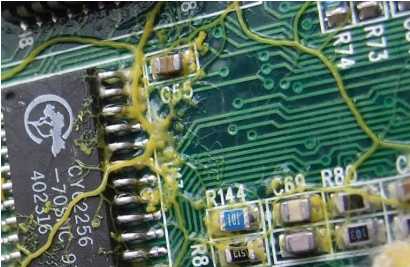| Grow Your Own Wiring |
| Written by Mike James | |||
| Saturday, 12 October 2013 | |||
|
A simple slime mould can be used to create living wiring between conventional electronic components. Its big problem is that it tends to go on growing and occasionally makes some additional connection but if you cut the main wire - it self-repairs. The Unconventional Computing Center and the group working under Andrew Adamatzky have produced some interesting uses of the slime mould Physarum polycephalum in the past, but this one sounds as though it just about could find a use. Slime mould is a very simple organism but it can produce protoplasmic tubes which it uses to move fluids from place to place. What has been discovered is that these tubes can conduct electricity; they can work at reasonable voltages and transfer enough current to light an LED. The resistance is about 800 ohms per cm but it varies a lot. How do you get the slime mould to wire things up as you want? Easy you put tasty snacks on the pins you want to connect and put something it doesn't like around anything you want to keep it away from. Given time the slime mould will grow a protoplasmic tube to connect the pins. To refine the steering you can also use electric fields.
Once connected the protoplasmic tubes will self-repair if they are cut with a knife. The protoplasmic tubes can even be grown on standard circuit boards. To improve their insulation they can be sprayed with a silicone oil - so this is still silicon-based electronics. However, to quote from the paper reporting the results: "Using living protoplasmic tubes as wires suffers from few disadvantages. Physarum is always in motion and newly developed protoplasmic tubes can interfere with existing tube-wires." Given that the tubes die after a few days it is suggested that perhaps it would be better to use dead tubes treated with a compound that keeps them conductive. As the paper concludes: "Results presented will be used in future designs of self-growing wetware circuits and devices, and integration of slime mould electronics into unconventional bio-hybrid systems."
More InformationPhysarum wires: Self-growing self-repairing smart wires made from slime mould Related ArticlesSlime Mold Simulates Canadian Transport System A Water Droplet-Based Computer
To be informed about new articles on I Programmer, install the I Programmer Toolbar, subscribe to the RSS feed, follow us on, Twitter, Facebook, Google+ or Linkedin, or sign up for our weekly newsletter.
Comments
or email your comment to: comments@i-programmer.info
|
|||
| Last Updated ( Saturday, 12 October 2013 ) |


